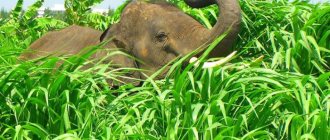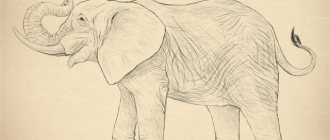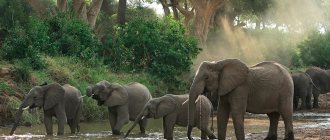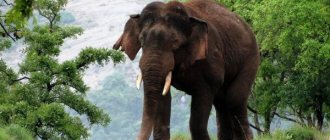- How long do elephants live?
The name of this amazing animal has long become a household name. “Like an elephant in a china shop” and many other popular expressions, aphorisms, and proverbs associated with elephants exist in our culture. And for good reason, because the elephant is perhaps one of the most interesting representatives of the animal world of our planet, and also one of the largest. More precisely, the elephant is the largest among all land animal species. Our article today is about him.
Description, structure, characteristics
Elephants truly look like giants among other animals. The height of the elephant is 2-4 m, with a weight of 3 to 7 tons. Moreover, elephants living in Africa are larger than elephants in Asia; some especially large African savannah elephants can weigh as much as 10-12 tons. The elephant's body is powerful, it is covered with thick brown or gray skin with deep wrinkles. The thickness of an elephant’s skin is on average 2.5 cm; it is not without reason that it has also become one of the common noun symbols of this creature; “thick-skinned like an elephant” they say, sometimes characterizing a person who is difficult to hurt or offend.
Also, elephants, unlike their closest relatives, mammoths (unfortunately extinct), have practically no vegetation on their bodies.
The elephant's head is quite large, with large signature ears. Nature gave elephants such size of ears not only for beauty, but they also play one very useful function - they regulate heat exchange. Fanning their ears allows elephants to increase their cooling effect.
The elephant's thick legs have two kneecaps, and this structure of their legs makes the elephant the only land animal that is unable to jump (however, elephants do not need to jump). In the center of the foot there is a special fat pad that springs with every step; it is this that allows elephants to move almost silently. But what is most interesting is that the sole of the elephant’s foot, when stepping on the ground, will sharply expand, thereby increasing the supporting surface, and narrow again when the elephant raises its foot up. This mechanism allows these heavy giants to move without much difficulty, including in swampy areas, without getting stuck in swamps.
The elephant's trunk is another unique feature of this animal, its calling card. In fact, the trunk of elephants is formed by the nose, fused with the upper lip. The 100 muscles + tendons that the elephant trunk possesses makes it strong and flexible. For elephants, the trunk has a number of important functions (in general, the trunk is about the same for them as hands are for us) - with its help they take food, pour water on themselves, communicate with each other and even raise their offspring. The trunk also provides elephants with a sense of smell and touch.
But the tusks of the elephant - another important attribute of this animal, to some extent, became its curse. The fact is that the high value of ivory at one time led to the mass extermination of elephants by hunters and poachers. But let's not talk about sad things, an elephant's tusks grow throughout its life and the stronger and more powerful they are, the older the elephant is.
Elephants also have a tail, which is the same length as their hind legs. The tip of the elephant's tail is framed by coarse hair, which helps ward off annoying insects.
Interesting fact: all elephants love and know how to swim. Also, despite their impressive size and apparent clumsiness, when running they can reach speeds of up to 50 km per hour.
Ancestors of modern giants
Ancient relatives of proboscis appeared on earth approximately 65 million years ago, during the Paleocene era. At this time, dinosaurs still walked the planet.
Scientists have found that the first representatives lived on the territory of modern Egypt and were more like a tapir. There is another theory, according to which the current giants descended from a certain animal that lived in Africa and almost all of Eurasia.
Research revealing how long the elephant has lived on our planet points to the existence of its ancestors.
- Deinotherium. They appeared approximately 58 million years ago and died out 2.5 million years ago. Outwardly they were similar to modern animals, but were noted for their smaller size and shorter trunk. Gomphotherium. They appeared on earth approximately 37 million years ago and died out 10 thousand years ago. Their body resembled the current long-nosed giants, but they had 4 small tusks, twisted in pairs up and down, and a flat jaw. At some stage of development, the tusks of these animals became significantly larger. Mamutids (mastodons). Appeared 10-12 million years ago. They had dense hair on their body, long tusks and a trunk. They became extinct 18 thousand years ago, with the advent of primitive people. Mammoths. The first representatives of elephants. They appeared from mastodons approximately 1.6 million years ago. They became extinct about 10 thousand years ago. They were slightly taller than modern animals, their body was covered with long and dense hair, and they had large tusks hanging down.
The African elephant and the Indian elephant are the only representatives of the proboscis order existing on Earth.
Nutrition
Given the huge size of elephants, these giants need a large amount of food. Elephants spend approximately 16 hours a day absorbing food; on average, an elephant eats 300 kg of vegetation per day. The food for herbivorous giants is grass, rhizomes,
leaves of trees, fruits of wild bananas, apples. The migrations of African elephants are associated with the search for food; usually a herd of elephants stays in a certain area until it is completely devastated, and when all the grass and all the leaves around are eaten, the elephants set off in search of new pastures with lush vegetation. Also, sometimes elephants cause significant damage to crops of corn, sweet potatoes and other agricultural crops. Elephants take food with their trunk and chew it with their molars.
Also, elephants not only eat a lot, but also drink just as much. An adult elephant drinks from 100 to 300 liters of water per day. It is not surprising that elephants are always near bodies of water.
What do elephants eat
Thick-skinned animals tear off strips of bark with their tusks. Roughage contains calcium and helps digestion.
Elephants also feast on:
- flowers;
- leaves;
- fruits;
- twigs;
- bamboo.
In general, the main food in nature is grass.
Elephants also consume between 80 and 120 liters of water every day. In hot weather they drink 180 liters, and an adult male inhales 250 liters with his trunk in less than 5 minutes!
Elephants eat earth
To supplement their diet, elephants dig for salt and minerals. The tusks lift the soil layer as the minerals are located deep in the ground.
What do elephants eat in captivity?
Elephants graze large areas of land in nature, eating plants of all sizes, from grass to trees. In captivity, elephants are given:
- sugar cane;
- lettuce;
- bananas;
- other fruits and vegetables.
Hay makes up the bulk of an elephant's diet in a zoo, circus or national park.
What do elephants eat in summer?
In the summer, when everything dries up and dies, elephants will eat whatever vegetation they can find, even the toughest bark and woody parts of plants! Elephants also dig up roots; roughage is removed from the elephant's gastrointestinal tract without being completely chewed or digested.
Can elephants adapt to new diets?
Due to their high intelligence, elephants change their feeding habits depending on their environment. Diverse ecosystems support the survival of elephants in forests, savannas, grasslands, swamps and deserts.
Enemies in nature
Given their size and power, elephants have no enemies in natural conditions. The only thing that bothers them is various annoying insects, which their thick skin and fanning tail help them get rid of.
However, the main enemy of elephants is, of course, humans, the reason for this is elephant tusks, which are very highly valued, and it is because of this that in the last twentieth century, the population of African elephants simply declined at a catastrophic rate. Part of the efforts to exterminate these giants were “enlightened” white hunters going to Africa on hunting safari. The elephant, which is one of the so-called “African Big Five,” was the desired prey of white hunters. Fortunately, now, instead of hunting safaris, tourists go on photo safaris; elephants are now protected by a number of African states and live in special national parks where hunting wild animals is strictly prohibited.
How many years does an elephant live?
The lifespan of an elephant in the wild is significantly shorter than that of its domesticated counterparts or those living in zoos or national reserves. This is due to the difficult conditions of the places where the elephant lives, with diseases and the brutal extermination of giants.
Scientists are still debating how long a wild elephant lives and what their life expectancy is in captivity.
Undoubtedly, how many years an elephant lives is determined by the species to which the mammal belongs. African savannas live the longest: among them there are individuals whose age reached 80 years. African forest proboscideans are somewhat smaller - 65-70 years. An Asian elephant at home or in zoos and national parks can live 55-60 years; in the natural environment, animals that have reached 50 years of age are considered long-livers.
How long elephants live depends on how the animal is cared for. A wounded and sick animal will not be able to live long. Sometimes even minor damage to the trunk or foot causes death. Under human supervision, many diseases of giants can be easily treated, which can significantly prolong life.
In their natural environment, animals have practically no enemies. Predatory animals attack only stray cubs and sick individuals.
Types, photos and names
All elephants, depending on their habitat, are divided into African and Asian, moreover, African elephants, in turn, are divided into savannah and forest elephants, we will dwell on them in detail below.
Savannah elephant
This is the largest representative of the elephant family. It lives in African shrouds along the equator throughout Africa. It has a dark color, strong tusks and a process on the edge of the trunk.
forest elephant
This African elephant is slightly smaller than its savanna relative. Has rounded ears. Lives in tropical African forests.
Indian elephant
The Indian elephant, which lives in Asia, is the only representative of the elephant family in these places. Despite its name, the Indian elephant lives not only in India, but also in many other neighboring countries: Burma, Thailand, China, Cambodia, Laos, Vietnam, Brunei, Indonesia. The Indian elephant is smaller in size than the savannah elephant; its distinctive features are small quadrangular-shaped ears and a process at the end of the trunk.
And these elephants, unlike their African counterparts, were tamed by humans; since ancient times, rich Indian rajahs rode elephants, and warriors used elephants, including for combat purposes. In the wars of the ancient world, such a war elephant was similar to a modern tank.
Where do elephants live?
The African elephant lives south of the Sahara Desert, in many African countries: Congo, Zambia, Kenya, Namibia, Somalia, Sudan and others. The fairly hot climate of the places where the elephant lives is to his liking. More often they choose savannas, where there is enough vegetation and water can be found. Animals practically do not enter deserts and impenetrable tropical forests.
Recently, the habitat of giants has decreased. Places where elephants live are turned into national reserves to preserve the population of these animals, protecting them from poachers.
But the Indian elephant, on the contrary, prefers forested areas of India, Vietnam, Thailand, China, Laos and Sri Lanka. He feels comfortable among dense bushes and thickets of bamboo. This Asian elephant once lived in almost all areas of southern Asia, but now populations have declined greatly.
The Indian elephant can live even in inaccessible jungles. It is in this area that the largest number of wild specimens remain. But determining how many years an elephant lives can be quite difficult.
Reproduction
Elephants live in family herds, with an average of 9-12 individuals, where the leader is the oldest female. Yes, matriarchy reigns in the elephant family. Female elephants reach sexual maturity at 12-14 years of age (exactly like humans), and by the age of 16, a female elephant is already capable of bearing cubs.
As for the males, after they reach sexual maturity at the age of 15-20 years, they leave their native herd and become single elephants. During certain mating periods, sensing that the females are ready to mate, the male elephant approaches the herd and begins courting the female elephant he likes. During this period, clashes often arise between male elephants, and then the desired female elephant goes to the strongest suitor.
An elephant's pregnancy lasts 20-22 months; childbirth takes place in the company of other females from the herd, who carefully surround the mother and newborn baby, protecting them from accidental danger. Usually only one baby elephant is born, in very rare cases there may be twins. A born elephant calf usually weighs about a hundredweight. The baby elephant develops very quickly, within a month he walks and sucks his mother's milk, travels with his relatives, grabbing his mother's tail with his trunk. Until two years old, elephant calves are fed with their mother's milk, and, interestingly, not only its mother, but also another lactating elephant can feed the baby elephant.
A little about the abilities and interesting qualities of elephants
- They often suffer from attached leeches. To remove them, the elephant takes a stick with its trunk and begins to scratch its skin. If he can’t cope on his own, his friend comes to the rescue, also with a stick. Together they get rid of parasites.
- There are albinos among elephants. They are called White Elephants, although they are not pure white in color, rather they have many light spots on their skin. They belong mainly to the Asian genus. In Siam they have always been considered an object of worship, a deity. Even the king was forbidden to ride it. Food for such an elephant was served on gold and silver dishes.
- Matriarchy reigns in the elephant herd. The most experienced female dominates. Elephants leave the herd at the age of 12 years. Females and juveniles remain.
- Elephants learn up to 60 commands and have the largest brains among land animals. They have a wide range of skills and behavioral elements. They can be sad, worried, help, bored, happy, play music and draw.
- Only humans and elephants have burial rituals. When the relative no longer shows signs of life, the remaining elephants dig a small hole, cover him in it with branches and dirt, and “mourn” next to it for several days. Incredibly, there were cases when they also did this to dead people.
- Elephants can be left-handed or right-handed. Depending on this, one of their tusks is better developed.
- The world's most famous elephant, Jumbo, was found in Africa near Lake Chad. In 1865, it was transported to the English Botanical Garden, then sold to America. For 3 years he traveled all over North America until he died in a train accident in Ontario.
Why are elephants afraid of mice?
It would seem an amazing paradox of nature, a mighty giant elephant is afraid of a small mouse. In fact, no, since the elephant’s fear of mice, which has become a “talk of the town,” is in reality nothing more than a myth, a legend, since elephants are not afraid of mice, zoo workers know this well, the elephants there are completely indifferent to small rodents and are not They pay no attention to them.
But where do the roots of this funny legend come from? There is a version that elephants are afraid of mice, because in the old days there were so many mice that they dared to attack elephants’ legs, and even managed to gnaw the elephants’ limbs to the bone. But this is just an explanation of a legend that has no basis in reality
An intoxicated elephant is extremely dangerous
This legend is very common among tourists planning to visit Africa. They say that drunken elephants and female elephants, maddened, rush across the steppes, breaking buildings and crushing small animals. There are rumors that they almost ambush people, trying to take them by surprise. All these are complete myths. Often stories about this are included in guidebooks in order to give the trip a touch of danger and extreme. Elephants do eat marula fruits, but they don’t get drunk from it. Although these fruits contain alcohol, the maximum effect is provided only by ripe fallen fruits, which an elephant would never pick up from the ground. It is impossible to imagine an elephant standing near a tree with ripe juicy fruits, waiting for them to finally ripen and fall into their mouth. Scientists have even calculated the number of fruits from which an elephant can actually get drunk - this will require about 27 liters of pure juice, that is, almost one and a half thousand ripe fruits, which is simply unrealistic. But there are many anecdotes about drunken elephants standing on their hind legs and relieving themselves in the bushes, or talking to travelers. Back in the early 19th century, scientists came to the conclusion that elephants eat these fruits to keep warm, but people just really want to see a drunk elephant, which is why they believe in this myth.
Why does an elephant have a long nose?
The long elephant trunk, also known as the nose, has also become food for many myths and legends. For example, one instructive African tale tells us about a curious little elephant who, wanting to find out who lives in the swamp, fell into the mouth of a crocodile. The crocodile grabbed the baby elephant by its nose, wanting to drag it under the water, but the baby elephant resisted with all its might and eventually escaped from the crocodile’s mouth, only after that its nose became long, long and turned into a trunk. And since then, they say, all elephants have long trunks as a result of the curiosity of that little elephant who stuck his nose where it shouldn’t.
In fact, the trunk of elephants was formed gradually as a result of millions of years of evolution. And what’s interesting is that young elephants spend several months learning the art of controlling their trunks.
Elephants can stand on their heads
Almost all of us have this belief - after all, we ourselves have seen circus acts. However, in nature, elephants never stand on their heads. In the arena, these numbers look quite harmless and even funny, but few people know that behind this lies exhausting and brutal training. Using beatings and deprivation of food, elephants are forced to perform circus acts, although these movements are contrary to the natural manners of the animal. For example, standing on one leg is simply dangerous for an animal, as it is subject to excessive overload. However, lashes, injections into sensitive areas and even electric shock do their job - this effect is much more noticeable than the pain from overstraining the joints. For elephants, even a wasp sting is very unpleasant; the skin begins to bleed. Therefore, in the circus, elephants are under constant mental and physical pressure, afraid of pain, waiting for food. Unfortunately, this is the only way to force animals to do actions not intended by nature.
Interesting Facts
Monkeys are included in the list of the most intelligent animals on the planet, they have an excellent memory, remember grievances and places of important events, have empathy, developed emotional experiences, are able to be happy, sad, and empathize with their loved ones.
The main function of an elephant is to carry heavy loads
The use of elephants as fighting units is widely known in history; in Southeast Asia they replaced cavalry, served as a means of transport or as a means of intimidation. Troops that included elephants had the greatest chance of victory, and the more of these fighters there were in the army, the greater the likelihood of success. War elephants even had special harnesses. The other side of these animals is also interesting. In the city of Lampang there is even an entire elephant center, where the inhabitants differ from their relatives in their ability to draw and play various musical instruments. Of course, this action takes place with the help of a person holding the canvas and helping to dip the brush into the paint. This center is very popular among tourists who willingly buy the paintings they like. Exhibitions of the most interesting works are also held there. Therefore, one should not reduce the capabilities of these animals only to physical work; the capabilities of elephants are varied and, without a doubt, humans still have a lot to learn about elephants.
Video
And in conclusion, an interesting documentary film “The Life of a Family of African Elephants”.
Author: Pavel Chaika, editor-in-chief of Poznavaika magazine
When writing the article, I tried to make it as interesting, useful and high-quality as possible. I would be grateful for any feedback and constructive criticism in the form of comments on the article. You can also write your wish/question/suggestion to my email [email protected] or Facebook, with respect, the author.
Author page
African forest elephant
To date, only two species have survived in the elephant family (Familia Elephantidae Sgau): Indian elephants, which are found in India, Sri Lanka, Bangladesh, as well as on the Indochina Peninsula, and African elephants, which zoologists divide into those living in savannas (savanna elephants) and living in tropical forests (forest elephants).
African and Indian elephants differ in body structure and disposition.
These differences are large enough that crossing elephants of two different species does not produce offspring.
The African elephant is taller than the Indian elephant, its ears are larger, its skin is rougher, its trunk is thinner, the tusks, which both males and females have, are more developed; The weight of males reaches 5 - 7.5 tons, females - 3 - 4 tons.
Indian male elephants weigh 4.5 - 5 tons, females - 3 - 4 tons; Females, as a rule, do not have tusks.
Both African and Indian elephants live in herds.
The basis of the herd is a family group of two to five, sometimes more, elephants related by family relationships (most often this is an old female elephant and her offspring of different generations).
Senses and intelligence
A characteristic external feature of an elephant is its trunk. Its weight can reach 200 kg. The trunk is an elongated nose fused with the upper lip . It provides the animal with breathing, touch, smell and grasping food. The flexible and strong organ includes more than 100 thousand strong muscles and tendons. With the help of their trunk, elephants tear off vegetation or draw in water, which they send into their mouths.
The trunk helps large creatures defend themselves from enemies and fight them. Although cubs can hold on to their mother's tail, until they are 1 year old they have difficulty controlling the organ, so they drink water on their knees.
Elephants have small eyes. It cannot be said that animals have acute vision, but they remember their relatives after a long separation, as well as their main sources of water and food. Animals are known for their excellent hearing and can recognize sounds even at low frequencies; they can hear thunder at a distance of up to 100 km. Elephants have a specific voice. Adults make sounds such as mooing, grunting, roaring and whispering.
In captivity, elephants tolerate mistreatment, but after a while they can become angry. These creatures always look calm, but they are capable of experiencing many different emotions - joy, sadness, anger, anger. Representatives of the elephant family are capable of laughing.
Although the huge creatures have small brains, they are considered one of the most intelligent animals on the planet. Elephants easily recognize themselves in the mirror, which indicates the presence of self-awareness. They use different items for their needs. For example, they may use branches as a fly swatter or fan.
Ears
The ears of the African elephant are usually larger than the ears of the Indian elephant. An extensive network of arteries and veins is present on their posterior surface, but the peripheral areas of the ears are relatively poorly supplied with blood. The ears perform the functions of acoustic perception, balancing and thermoregulation. With their help, elephants can make signs. These animals have very sensitive hearing. The slightest sound is enough to attract the elephant's attention and disturb its peace. Elephants were the first animals to discover the ability to produce infrasound. It has been established that infrasound allows animals to communicate over long distances. Elephants cannot hear sounds with a frequency higher than 10,500 Hz with an intensity of 6o dB; at higher decibels, they cannot hear sounds from 12,000 Hz. However, they can easily distinguish low-frequency sounds (better than other animals). The limit of human audibility for low-frequency sounds is 29 Hz, but elephants can hear sounds at a level of 17 Hz. It is hypothesized that elephants cannot hear ultrasound (high-frequency sounds) due to the large interaural distance (distance between the ears). The sound reaches the second ear much later than the first. In addition, the intensity of sound is perceived by the ear located closer to the source more strongly than by the other ear, since the head acts as a buffer that delays sound. In animals with a small distance between the ears, there is no such buffer, the sound intensity does not decrease, so they can hear ultrasound.
Interesting information
There are many myths and legends about elephants. Many people still think that huge creatures are afraid of mice, but this is not true. The small rodents are unable to gnaw holes in elephants' thick legs or eat them from the inside. And mice are unlikely to be able to climb into the trunk and suffocate the creature. The giant can exhale forcefully and thus get rid of the rodent.
But there are many other interesting facts about elephants that not everyone knows:
- These creatures can be either right-handed or left-handed. This can be determined by the ground off tusk on one side, which they use more often in their lives.
- Elephants can swim and move along the bottom of various bodies of water, breathing with their trunk above the water.
- The speed of large mammals on land reaches 4-6 km/h, and when running, animals increase it to 40-50 km/h.
- Female Indian elephants do not have tusks.
- Individuals of the African species sleep standing, leaning on each other. Asian elephants sleep lying down.
- Representatives of the elephant family do not have sebaceous glands, so they do not sweat.
- Animals have almost no enemies. Predators are only dangerous to their young.
- Mammals skillfully use their trunks and can lift even a fragile object without damaging it.
- In the past, elephants were used as fighting creatures and labor. Today they can also benefit humans: giants help overcome places that are impassable for humans.
Elephants are unique creatures in their physiology, anatomy and way of life. Therefore, people must make every effort to preserve the last species of majestic creatures, of which there are not many left on our planet.











